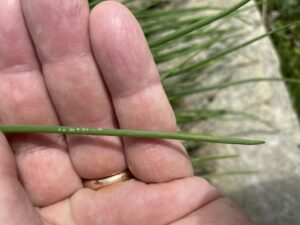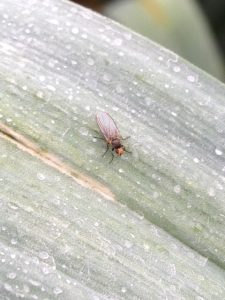Allium Leaf Miner (ALM)
 Allium leaf miner (ALM) feeding/egg laying scars have been detected in Cape May County as of 4/3/22 (see photo at left). It is likely that this pest is active, and depositing eggs in alliums throughout south Jersey at this time. Many weather stations in southern and central counties exceeded 250 growing degree days (GDD) base 39˚F over a week ago, with northern counties surpassing this threshold more recently. 39˚F is close to the lower developmental temperature (38.3˚ F) which our colleagues at Penn State recommend for predicting the first emergence of ALM adults. Last year, initial feeding/egg laying scars were detected within a few days of local weather stations recording the 250 GDD threshold.
Allium leaf miner (ALM) feeding/egg laying scars have been detected in Cape May County as of 4/3/22 (see photo at left). It is likely that this pest is active, and depositing eggs in alliums throughout south Jersey at this time. Many weather stations in southern and central counties exceeded 250 growing degree days (GDD) base 39˚F over a week ago, with northern counties surpassing this threshold more recently. 39˚F is close to the lower developmental temperature (38.3˚ F) which our colleagues at Penn State recommend for predicting the first emergence of ALM adults. Last year, initial feeding/egg laying scars were detected within a few days of local weather stations recording the 250 GDD threshold.
Growers should consider initiating the control method of their choice at this time. Affected crops include chives, scallions, garlic, onions and leeks. Look for neat rows of white spots descending from the upper tips of allium leaves. Initial injury often occurs on the tallest leaves. Under warmer, less breezy conditions, adults may be seen near the tips of leaves (see photo of adult at lower right).
Floating row covers, kept on until this flight ends will help minimize access to plants. Insecticide applications targeting adults may be helpful as well, although frequency of applications is uncertain. Spinosyn materials (Radiant, Entrust (OMRI approved)), pyrethroids (Mustang Maxx,  Warrior), neonicotinoids (Scorpion, Venom), the diamide Exirel (section 2ee recommendation) and the insect growth regulator Trigard are labeled for miner control.
Warrior), neonicotinoids (Scorpion, Venom), the diamide Exirel (section 2ee recommendation) and the insect growth regulator Trigard are labeled for miner control.
Adult activity and observations of feeding will be reported on in the IPM Update as they occur. At this time, all growers should prepare to respond to the first adult generation. We will deploy yellow sticky cards and attempt to identify the end of the first flight so that growers know when the risk of infestation has abated.

